When to Buy a Kitchen Table: Factors to Consider for Your Home, Including Material Differences

Introduction: A kitchen table is an essential piece of furniture in any home, serving as a hub for family meals, social gatherings, and everyday activities. If you're considering buying a new kitchen table, it's important to make an informed decision based on various factors, including the material it's made of. In this article, we will discuss practical tips and recommendations, along with examples, to help you determine when the best time is to buy a kitchen table for your home, with a focus on the differences between various materials.

Content:
- Assess Your Budget and Affordability:
- Set a budget for purchasing a kitchen table and consider factors such as material, size, and design that can affect the cost. For example, a solid wood kitchen table may be more expensive than a laminate or metal one.
- Research and compare the price ranges of different materials used in kitchen tables to align with your budget and affordability. For instance, a glass or metal kitchen table may be more budget-friendly compared to a high-quality hardwood table.
- Evaluate Your Space and Room Layout:
- Measure the available space in your kitchen or dining area to ensure the kitchen table will fit comfortably. For example, if you have a small kitchen, a round or square table may be a better fit compared to a large rectangular table.
- Consider the size, shape, and style of the kitchen table in relation to your space and room layout, taking into account the materials used and their impact on the overall aesthetics. For instance, a rustic farmhouse-style kitchen table made of reclaimed wood may be a perfect fit for a spacious country-style kitchen.
- Consider Your Style and Design Preferences:
- Reflect on your personal style and design preferences when selecting a kitchen table material. For example, if you prefer a modern and sleek look, a glass or metal table may be a better choice compared to a traditional wooden table.
- Research and compare the aesthetics of different materials, such as wood, metal, glass, and laminate, to find a material that aligns with your style and design choices. For instance, a natural wood table with a distressed finish may complement a rustic or vintage-inspired kitchen.
- Assess Durability and Maintenance Needs:
- Consider the durability and maintenance requirements of the material used in the kitchen table. For example, a solid hardwood table may require more maintenance, such as periodic polishing and sealing, compared to a metal or glass table.
- Research and compare the durability and maintenance characteristics of different materials, such as wood, metal, glass, and laminate, to find a material that fits your lifestyle and maintenance preferences. For instance, a laminate table may be more resistant to stains and scratches compared to a wooden table, making it a practical choice for a busy family with young children.
- Prioritize Comfort and Functionality:
- Consider the comfort and functionality of the kitchen table material for everyday use. For example, a table with a smooth glass top may be easy to clean, but it may not be as comfortable for long hours of sitting compared to a cushioned chair on a wooden or upholstered chair.
- Evaluate factors such as texture, heat resistance, and stability of different materials to ensure the table will meet your comfort and functionality needs. For instance, a wooden table with a heat-resistant finish may be a better option if you plan on placing hot pots or pans directly on the table.
- Consider Environmental Impact:
- Consider the environmental impact of the material used in the kitchen table. For example, opting for a table made of reclaimed wood or bamboo can be a more sustainable choice compared to a table made of virgin wood or other less eco-friendly materials.
- Research and compare the environmental impact of different materials, such as wood, metal, glass, and laminate, to make an informed decision that aligns with your sustainability values. For example, a kitchen table made of reclaimed wood can be a great option for reducing deforestation and minimizing carbon footprint.
Conclusion: When it comes to buying a kitchen table, there are several factors to consider, including your budget, space, style preferences, durability, comfort, functionality, and environmental impact. By evaluating these factors and researching the materials used in kitchen tables, you can make an informed decision that meets your needs and aligns with your values. Remember to assess your budget, evaluate your space, consider your style preferences, assess durability and maintenance needs, prioritize comfort and functionality, and consider the environmental impact of the material. With careful consideration, you can find a kitchen table that not only enhances the aesthetics of your home but also serves as a functional and sustainable piece of furniture for years to come.
Example: For instance, if you have a limited budget and a small kitchen space, you may opt for a budget-friendly option like a laminate kitchen table in a round shape that fits well in your compact dining area. On the other hand, if you have a larger budget and a spacious kitchen, you may choose a high-quality solid wood table with a unique distressed finish to complement your rustic farmhouse-style kitchen. If sustainability is a priority for you, you may opt for a kitchen table made of reclaimed wood or bamboo, which not only adds a touch of eco-friendliness to your home but also adds a unique and natural element to your kitchen decor.
By considering these factors and examples, you can make a well-informed decision on when to buy a kitchen table that fits your needs, preferences, and budget while taking into account the material differences and environmental impact. Happy table hunting!
Example: For instance, if you have a limited budget and a small kitchen space, you may opt for a budget-friendly option like a laminate kitchen table in a round shape that fits well in your compact dining area. On the other hand, if you have a larger budget and a spacious kitchen, you may choose a high-quality solid wood table with a unique distressed finish to complement your rustic farmhouse-style kitchen. If sustainability is a priority for you, you may opt for a kitchen table made of reclaimed wood or bamboo, which not only adds a touch of eco-friendliness to your home but also adds a unique and natural element to your kitchen decor.
By considering these factors and examples, you can make a well-informed decision on when to buy a kitchen table that fits your needs, preferences, and budget while taking into account the material differences and environmental impact. Happy table hunting!
FAQs:
-
What are the cost differences between various kitchen table materials?
FAQ Answer: The cost of kitchen tables varies widely depending on the material. Laminate or metal tables tend to be more affordable, while high-quality hardwood tables are at the higher end of the price spectrum. Assessing your budget is crucial before researching the price ranges of different materials to find a table that aligns with your financial plan. -
How do I choose the right size and shape kitchen table for my space?
FAQ Answer: To ensure a perfect fit for your kitchen or dining area, measure your available space before deciding on a table. For smaller kitchens, round or square tables can save space, whereas larger areas might accommodate rectangular tables. The room's layout and the table's style, size, and material should also influence your decision. -
Which kitchen table materials are best for durability and low maintenance?
FAQ Answer: The durability and maintenance needs of kitchen table materials can vary. Hardwood tables often require more upkeep, such as periodic polishing, whereas metal or glass tables might be easier to maintain. Laminate tables are known for their resistance to stains and scratches, making them ideal for families with children.
-
Posted in
island table





